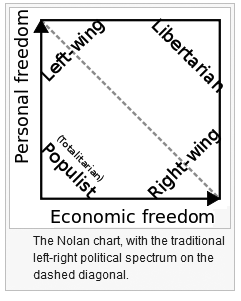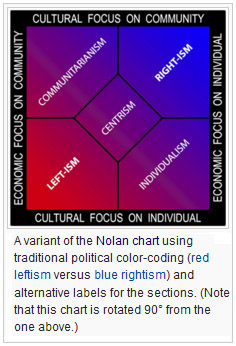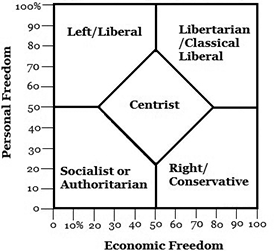Conservative, Liberal, or both?
In the article Top Five Reasons Not to Vote, Doug Casey notes in a Libertarian missive that "voting encourages politicians". Actually, the opposite is more accurate - that if you don't vote you encourage politicians. In other words, voting is the primary constraint that sovereign Americans can impose on their elected public servants. As in "vote the bums out!"
But who do you vote for as a candidate? Are you a liberal (left) or a conservative (right)? Where do the candidates fall along the liberal - conservative line?
Casey points out that the single liberal conservative dimension is particularly constraining. Not only do these abstract terms change with every politician, they change over time. He notes that:
In the 19th century, a liberal was someone who believed in free speech, social mobility, limited government, and strict property rights. The term has since been appropriated by those who, although sometimes still believing in limited free speech, always support strong government and weak property rights, and who see everyone as a member of a class or group.
Conservatives have always tended to believe in strong government and nationalism... Today's conservatives are sometimes seen as defenders of economic liberty and free markets, although that is mostly true only when those concepts are perceived to coincide with the interests of big business and economic nationalism.
Bracketing political beliefs on an illogical scale, running only from left to right, results in constrained thinking...
Politics is the theory and practice of government. It concerns itself with how force should be applied in controlling people, which is to say, in restricting their freedom. It should be analyzed on that basis...
Casey delineates two fundamental types of freedom: social and economic. He then suggests that the political spectrum can be more accurately portrayed in a two-dimensional chart representing both social and economic freedom.
Thus, for example, a person or a candidate may lean toward personal freedom but not economic freedom - in other words, the government should not interfere with personal lifestyle choices, but it should direct the economy. Or a person or candidate may favor the opposite, or may fall anywhere within the chart.
The Nolan Chart
Casey's chart is a derivative of the Nolan Chart, which is a political view assessment diagram created by David Nolan in 1969. The chart represents political opinion along two axes: economic and personal. It presents political views according to degrees of economic and personal freedom. Nolan stated that when someone views this chart, it causes an irreversible change: viewers subsequently view the political orientations in two dimensions instead of one.

Economic freedom relates to what people do as producers and consumers and what they do with their money. For example: where they work, ability to start a business, and ability to buy a home. Personal freedom relates to self-expression, and what people do with their minds and bodies. For example: recreational activities, membership in organizations, and drugs and foods they consume.
Most government control and involvement falls within these two arenas of economics and personal activity. Wikipedia notes that:
The extremes are no government at all in either area (anarchism) or total or near-total government control of everything (various forms of totalitarianism). Most political philosophies fall somewhere in between. In broad terms:
• Conservatives and those on the right tend to favor more freedom in economic areas (example: a free market), but more government intervention in personal matters (example: drug laws).
• Liberals and those on the left (by the common US meanings of those terms) tend to favor more freedom in personal areas (example: no military draft), but more government activism or control in economics (example: a government-mandated minimum wage).
• Libertarians favor both personal and economic freedom, and oppose most (or all) government intervention in both areas. Like conservatives, libertarians believe that people should be free to make economic choices for themselves. Like liberals, libertarians believe in personal freedom.
• Statists favor a lot of government control in both the personal and economic areas. Different versions of the chart, as well as Nolan's original chart, use terms such as "communitarian" or "populist" to label this corner of the chart.
Here's another version of the Nolan Chart which uses traditional left (red) versus conservative (blue) coloration:

(The above two charts courtesy Wikipedia).
Additional dimensions
Of course, there exist political categories or dimensions other than personal and economic. For example, the environmental dimension extends along an axis from:
nature is there for man's taking (anthropocentrism)
balancing human impact with nature (environmentalism)
protecting future generations - of all species (deep ecology)
Thus, it would be possible to be an environmentalist and a liberal (it seems that many environmentalists fall into this category). But it would also be consistent to be a deep ecologist while being fundamentally conservative (indeed, the late Middle English root of "conservative" is to conserve or preserve).
Similarly, additional dimensions might include international versus domestic priorities, free market system versus social collectivism, empire-building warfare versus peace, etc.
Where do you stand?
A number of self-administered quizzes are available for you to find out where you fit. They aren't perfect, but they are interesting to take. Here are a few:
The World's Smallest Political Quiz
Best Political Quiz - This quiz measures political positions along five axes: Overall Standing, International Affairs, Social, Environment, and Economic.
The Enhanced Precision Political Quiz...in 2D
I Side With: 2016 Presidential Election - How do your beliefs align with the potential candidates?
(When taking any quiz online, don't provide personal information that could be used for tracking purposes.)

